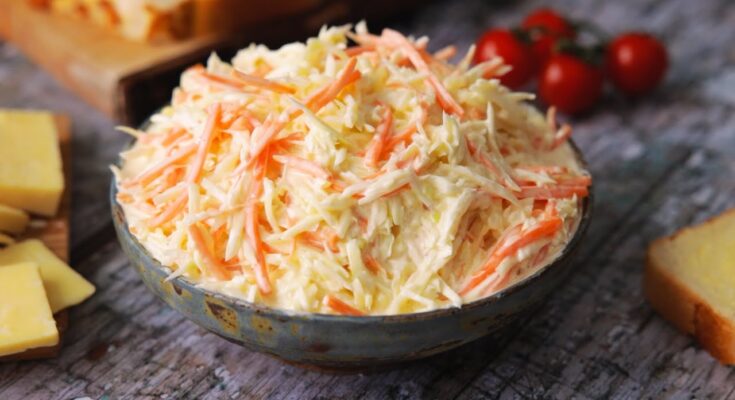Coleslaw Recipe: Coleslaw is a classic dish that’s known for its refreshing crunch and tangy flavor. Whether you’re serving it as a BBQ side, topping for sandwiches, or a standalone salad, it’s one of those recipes that’s incredibly easy to make but always leaves a lasting impression.
In this step-by-step guide, we’ll take you through how to make a perfect coleslaw, from choosing the right ingredients to mixing it all up for that unbeatable texture and taste.
What is Coleslaw?
Coleslaw, derived from the Dutch term “koolsla” (meaning cabbage salad), is a dish primarily made from shredded raw cabbage mixed with dressing. Though traditionally associated with a creamy, mayonnaise-based dressing, there are countless variations worldwide, from tangy vinegar-based coleslaws to sweet fruity versions.
Why It’s a Perfect Side Dish
Coleslaw’s versatility makes it an ideal companion for various meals. It adds a fresh, crunchy element to heavy dishes like pulled pork, ribs, or fried chicken, balancing out the richness with its bright, acidic flavors. Plus, it’s easy to make in bulk and can be prepared ahead of time.
Ingredients for Classic Coleslaw
Core Vegetables:
- Cabbage: The star ingredient. You can use green cabbage, red cabbage, or a mix of both for a more colorful presentation.
- Carrots: Grated carrots add sweetness and a pop of color to the dish.
Dressing Ingredients:
- Mayonnaise: The creamy base for a classic coleslaw dressing.
- Vinegar (white or apple cider): Adds tang to balance the richness of the mayo.
- Sugar: Just a bit to offset the vinegar’s sharpness.
- Dijon Mustard: Adds depth and a slight sharpness.
- Salt and Pepper: Essential seasonings to taste.
Optional Add-ins:
- Thinly sliced onions for a sharper bite.
- Celery seeds or poppy seeds for added texture.
- A touch of lemon juice for extra tang.
Types of Coleslaw
Mayonnaise-Based Coleslaw
This is the traditional creamy version most people are familiar with. The richness of the mayo is balanced by vinegar and a touch of sugar.
Vinegar-Based Coleslaw
This lighter version skips the mayonnaise and instead uses a tangy vinegar-based dressing. Perfect for those looking for a lower-fat or dairy-free option.
Regional Variations
Southern-style coleslaw often has a sweeter profile, while Asian-inspired versions might include ingredients like soy sauce, sesame oil, or ginger.
Tools You’ll Need
- A large mixing bowl
- Grater or food processor (for shredding)
- Whisk for mixing the dressing
- Measuring cups and spoons
Preparing the Vegetables
Shredding the Cabbage
First, remove any tough outer leaves from the cabbage. Slice the cabbage in half, remove the core, and then use a sharp knife or food processor to thinly shred it. A mandoline slicer works well too if you want super-thin slices.
Grating Carrots
Peel and grate the carrots. You can use a box grater or a food processor to make this step quicker. The carrots will add both sweetness and texture.
Optional Vegetables
You can include thinly sliced onions, bell peppers, or even radishes to add more flavor complexity.
Making the Coleslaw Dressing
Mayonnaise-Based Dressing
- In a small bowl, whisk together 1 cup of mayonnaise, 2 tablespoons of apple cider vinegar, 1 tablespoon of Dijon mustard, 1 tablespoon of sugar, salt, and pepper to taste.
- Mix until smooth and creamy. Taste and adjust seasonings as needed.
Vinegar-Based Dressing
- For a lighter version, mix 1/4 cup of apple cider vinegar, 2 tablespoons of olive oil, 1 tablespoon of sugar, and a pinch of salt and pepper.
- Whisk until the sugar is dissolved.
Combining the Vegetables and Dressing
Place the shredded cabbage and grated carrots into a large mixing bowl. Pour the dressing over the vegetables and gently toss to combine. Be careful not to overmix, as this can make the coleslaw soggy. The key is to coat the vegetables lightly without drowning them in dressing.
Allowing the Flavors to Marinate
Once mixed, allow the coleslaw to sit in the fridge for at least 30 minutes to let the flavors meld. This rest period is crucial for softening the cabbage slightly while still retaining its crunch.
Seasoning and Tasting
Before serving, taste the coleslaw again and adjust the seasoning. You might want to add more salt, pepper, or a splash of vinegar to brighten it up. If the coleslaw tastes a bit too sharp, a little more sugar can balance it out.
Serving Suggestions
Coleslaw pairs wonderfully with a wide variety of dishes:
- Serve it as a side for BBQ ribs, fried chicken, or pulled pork.
- Add it to sandwiches, burgers, or tacos for extra crunch and freshness.
- Use it as a topping for grilled fish or in wraps for a healthy crunch.
Storing and Shelf Life
Coleslaw can be stored in an airtight container in the fridge for up to 3 days. However, it’s best enjoyed within the first 24 hours to retain its crunch and vibrant flavors.
Creative Variations of Coleslaw
Apple and Raisin Coleslaw
For a sweeter twist, add thinly sliced apples and a handful of raisins to your coleslaw. The fruit complements the tangy dressing beautifully.
Spicy Jalapeño Coleslaw
Kick up the heat by adding finely chopped jalapeños or a dash of cayenne pepper.
Nutty Crunch Coleslaw
Add some toasted sunflower seeds, almonds, or walnuts for a satisfying crunch and a boost of protein.
Mistakes to Avoid
- Overdressing: Too much dressing can make the coleslaw soggy. Start with less, and add more if needed.
- Finely Shredded Vegetables: If the vegetables are too finely shredded, they can lose their crunch and become limp.
- Serving Immediately: Coleslaw tastes best when allowed to rest in the fridge for at least 30 minutes.
Healthy Substitutes
You can make coleslaw healthier by using Greek yogurt instead of mayonnaise, cutting back on sugar, or using honey as a natural sweetener.
FAQs about Coleslaw Recipe
What type of cabbage is best for coleslaw?
Green cabbage is most commonly used for its crunchy texture and mild flavor. However, red cabbage or a mix of both can add a colorful twist to your dish.
Can I make coleslaw ahead of time?
Yes, you can prepare coleslaw ahead of time. For the best texture, mix the dressing with the cabbage a few hours before serving. This allows the flavors to meld together while maintaining the cabbage’s crunch.
What are some healthy alternatives to mayonnaise in coleslaw?
Greek yogurt or sour cream are excellent healthier alternatives to mayonnaise. They provide a creamy texture with less fat. For a vegan option, consider using vegan mayo or a vinaigrette made with olive oil and vinegar.
How long does homemade coleslaw last?
Homemade coleslaw can last in the refrigerator for up to 3-5 days. Make sure it’s stored in an airtight container to maintain freshness.
Can coleslaw be frozen?
It is not recommended to freeze coleslaw due to the high water content in cabbage, which can lead to a soggy, watery texture upon thawing.
What are some creative add-ins for coleslaw?
To add extra flavor and texture, consider incorporating ingredients like shredded carrots, apple slices, raisins, or nuts. Fresh herbs like parsley or cilantro can also enhance the taste.
Is coleslaw gluten-free?
Coleslaw can be gluten-free, but it’s important to check the labels on pre-made dressings or mayonnaise to ensure they do not contain gluten-containing additives.
Conclusion
In conclusion, making homemade coleslaw is not just about mixing cabbage and carrots; it’s an opportunity to elevate a simple side dish into something spectacular. By preparing your coleslaw at home, you have complete control over the ingredients, allowing you to adjust the flavors to suit your taste and dietary preferences.
The freshness of the ingredients ensures a crunchier, more flavorful bite that far surpasses anything you can buy pre-made. Additionally, the ability to experiment with different ingredients, such as adding apples for a sweet crunch or a hint of mustard for depth, makes this homemade coleslaw recipe a worthwhile endeavor.
Not only does it enhance your meals, but it also adds a personal touch to your dining experience. Give it a try, and you’ll see that the minimal effort required is well worth it for the superior taste and health benefits.



